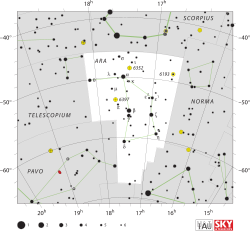astro.wikisort.org - Star
Rho1 Arae is the Bayer designation for a star in the southern constellation of Ara. Unusually for a star with a Bayer designation, it was not catalogued by Bayer in his Uranometria. It was instead first catalogued by Nicolas Lacaille, in his Coelum Australe Stelliferum published in 1763. This star gained the Bayer designation of Rho1 Arae in Bode's Uranographia, published in 1801. Rho1 Arae is one of the dimmest stars with a Bayer designation, having an apparent visual magnitude of just +6.275[2] According to the Bortle Dark-Sky Scale, this means the star is just barely visible to the naked eye in dark rural skies. Based upon parallax measurements, it is about 640 light-years (200 parsecs) distant from the Sun, give or take a 50-light-year margin of error.[1]
![A light curve for V846 Arae, plotted from TESS data[10]](http://upload.wikimedia.org/wikipedia/commons/thumb/7/7f/V846AraLightCurve.png/220px-V846AraLightCurve.png)

| |
| Observation data Epoch J2000 Equinox J2000 | |
|---|---|
| Constellation | Ara |
| Right ascension | 16h 56m 08.8405s[1] |
| Declination | –50° 40′ 29.244″[1] |
| Apparent magnitude (V) | 6.275[2] |
| Characteristics | |
| Spectral type | B3 Vnpe |
| U−B color index | –0.691[2] |
| B−V color index | +0.008[2] |
| Astrometry | |
| Radial velocity (Rv) | +19[3] km/s |
| Proper motion (μ) | RA: –7.66[1] mas/yr Dec.: –9.79[1] mas/yr |
| Parallax (π) | 5.06 ± 0.39 mas[1] |
| Distance | 640 ± 50 ly (200 ± 20 pc) |
| Absolute magnitude (MV) | −0.16[4] |
| Details | |
| Mass | 6.3 ± 0.1[5] M☉ |
| Luminosity | 1,418[6] L☉ |
| Surface gravity (log g) | 3.75[7] cgs |
| Temperature | 19,800[7] K |
| Rotational velocity (v sin i) | 370 ± 10[8] km/s |
| Age | 18.4 ± 1.5[5] Myr |
| Other designations | |
| Database references | |
| SIMBAD | data |
This is a spectroscopic binary system, which means that the presence of an orbiting companion is indicated by shifts in the spectrum. However, because the primary component is spinning rapidly with a projected rotational velocity of 370 ± 10, it is difficult to obtain reliable orbital elements. The orbital period has been estimated at 0.439 day. The spectrum of this system matches a stellar classification of B3 Vnpe, which may indicate the primary is a B-type main-sequence star. The 'e' suffix indicates the presence of emission lines, indicating this is a Be star. For Rho1 Arae, the emission lines are prominent and variable.[8]
Rho1 Arae has a peculiar velocity of 27.4 ± 4.9 km/s relative to its neighbors,[5] making it a runaway star system. A scenario that it was ejected from the Scorpius–Centaurus OB association as a result of a past supernova explosion seems unlikely because of its binarity.[8]
References
- van Leeuwen, F. (November 2007), "Validation of the new Hipparcos reduction", Astronomy and Astrophysics, 474 (2): 653–664, arXiv:0708.1752, Bibcode:2007A&A...474..653V, doi:10.1051/0004-6361:20078357, S2CID 18759600.
- Kozok, J. R. (September 1985), "Photometric observations of emission B-stars in the southern Milky Way", Astronomy and Astrophysics Supplement Series, 61: 387–405, Bibcode:1985A&AS...61..387K.
- Evans, D. S. (June 20–24, 1966), "The Revision of the General Catalogue of Radial Velocities", in Batten, Alan Henry; Heard, John Frederick (eds.), Determination of Radial Velocities and their Applications, Proceedings from IAU Symposium no. 30, vol. 30, University of Toronto: International Astronomical Union, p. 57, Bibcode:1967IAUS...30...57E.
- Anderson, E.; Francis, Ch. (2012), "XHIP: An extended hipparcos compilation", Astronomy Letters, 38 (5): 331, arXiv:1108.4971, Bibcode:2012AstL...38..331A, doi:10.1134/S1063773712050015, S2CID 119257644.
- Tetzlaff, N.; Neuhäuser, R.; Hohle, M. M. (January 2011), "A catalogue of young runaway Hipparcos stars within 3 kpc from the Sun", Monthly Notices of the Royal Astronomical Society, 410 (1): 190–200, arXiv:1007.4883, Bibcode:2011MNRAS.410..190T, doi:10.1111/j.1365-2966.2010.17434.x, S2CID 118629873.
- Hohle, M. M.; Neuhäuser, R.; Schutz, B. F. (April 2010), "Masses and luminosities of O- and B-type stars and red supergiants", Astronomische Nachrichten, 331 (4): 349, arXiv:1003.2335, Bibcode:2010AN....331..349H, doi:10.1002/asna.200911355, S2CID 111387483.
- Soubiran, C.; Le Campion, J.-F.; Cayrel de Strobel, G.; Caillo, A. (June 2010), "The PASTEL catalogue of stellar parameters", Astronomy and Astrophysics, 515: A111, arXiv:1004.1069, Bibcode:2010A&A...515A.111S, doi:10.1051/0004-6361/201014247, S2CID 118362423.
- Jilinski, E.; et al. (September 2010), "A Dynamical Study of Suspected Runaway Stars as Traces of Past Supernova Explosions in the Region of the Scorpius–Centaurus OB Association", The Astrophysical Journal, 721 (1): 469–477, Bibcode:2010ApJ...721..469J, doi:10.1088/0004-637X/721/1/469.
- "rho01 Ara". SIMBAD. Centre de données astronomiques de Strasbourg. Retrieved 2012-08-01.
{{cite web}}: CS1 maint: postscript (link) - "MAST: Barbara A. Mikulski Archive for Space Telescopes". Space Telescope Science Institute. Retrieved 8 December 2021.
External links
Другой контент может иметь иную лицензию. Перед использованием материалов сайта WikiSort.org внимательно изучите правила лицензирования конкретных элементов наполнения сайта.
WikiSort.org - проект по пересортировке и дополнению контента Википедии